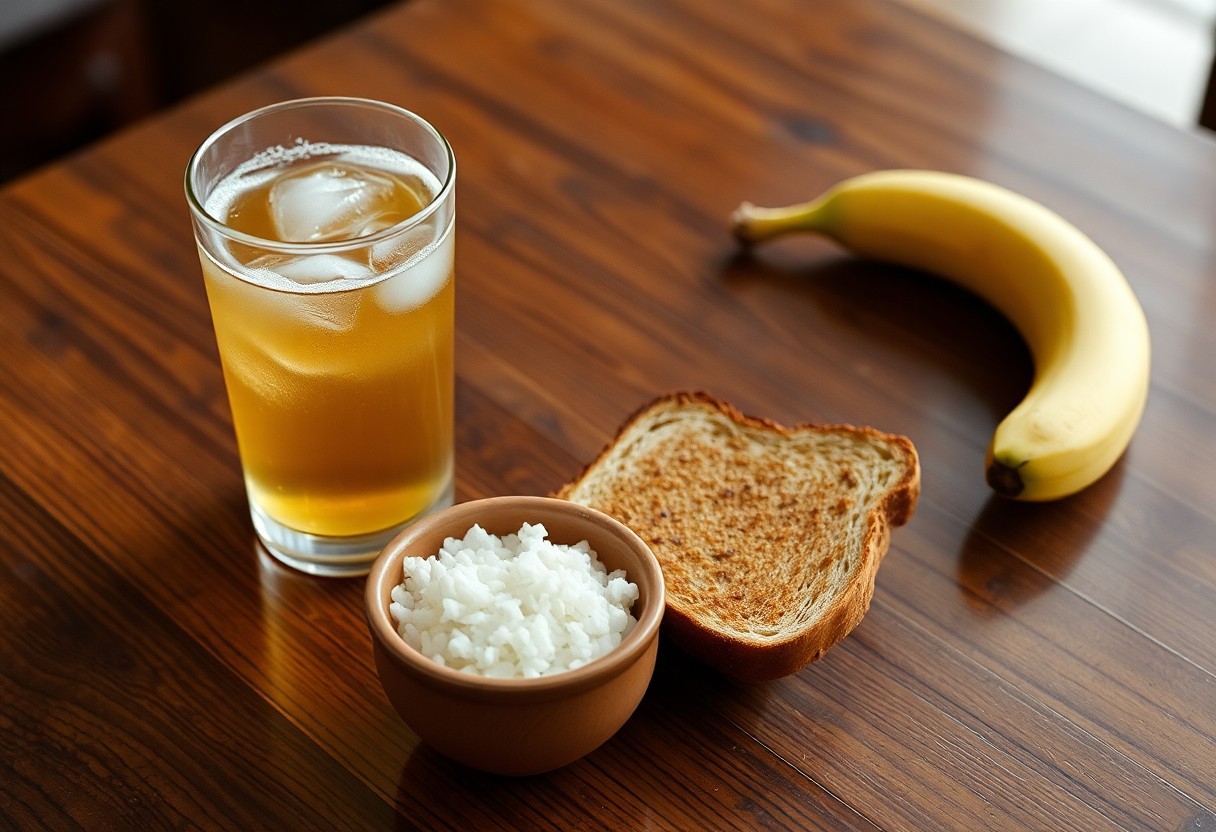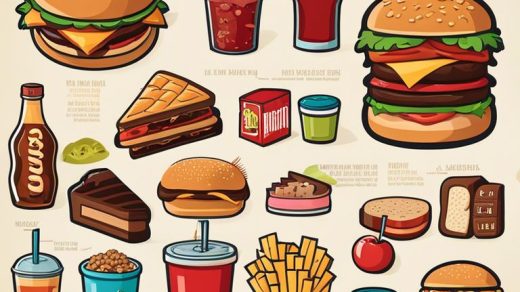There’s a lot you might wonder about what to eat after experiencing vomiting, as your body needs gentle nourishment to recover. Initially, starting with bland foods is advisable to help your stomach settle. A good option is the BRAT Diet for Upset Stomach or Vomiting, which includes bananas, rice, applesauce, and toast. Gradually reintroducing other soft, easy-to-digest foods can also aid your recovery process, ensuring that you feel better sooner.
Key Takeaways:
- Hydration: After vomiting, it is important to replenish lost fluids with water, herbal teas, or clear broths.
- Gentle Foods: Introduce bland foods such as crackers, rice, or bananas to help ease your stomach back to normal.
- Avoid Irritants: Stay away from spicy, fatty, or dairy foods initially, as they can aggravate the stomach further.
Understanding the Body’s Needs After Vomiting
Before you choose what to eat after vomiting, it’s important to understand your body’s needs during this recovery phase. Your stomach may be sensitive, and your body is likely depleted of nutrients and fluids. It’s important to approach food and hydration thoughtfully, as your digestive system may need time to adjust. Listening to your body’s signals will help guide your choices effectively.
Importance of Rehydration
For recovery after vomiting, rehydration is fundamental to restoring your body’s fluid balance. Vomiting can lead to significant fluid loss, making it vital to replenish electrolytes and fluids. Drinking clear fluids or electrolyte solutions can help you regain hydration and prevent further complications.
Nutritional Considerations
Across your recovery, focusing on easily digestible foods is important for your overall comfort and nutrition. Start with bland options like bananas, rice, applesauce, and toast, as they are gentle on your stomach while providing important nutrients.
Another key aspect of nutritional considerations is the gradual reintroduction of foods. Once you feel ready for solid food, opt for low-fat, easily digestible options to ensure that your stomach can handle them without exacerbating nausea. You might also want to incorporate small amounts of protein, such as boiled eggs or yogurt, which can assist in rebuilding lost nutrients while being gentle on your system.


Foods to Eat After Vomiting
One of the most important aspects of recovery after vomiting is choosing the right foods. Start with bland, easy-to-digest options that minimize irritation to your stomach. Foods like applesauce, plain toast, crackers, and bananas can help restore your energy levels and provide necessary nutrients. Stay hydrated with clear fluids such as water, broth, or electrolyte drinks to prevent dehydration.
Easy-to-Digest Options
One effective way to ease your digestive system back into routine is by opting for simple, easy-to-digest options. Foods like plain rice, boiled potatoes, and yogurt can be gentle on your stomach while providing some nourishment. These foods help settle your digestive tract, allowing you to gradually restore your appetite without overwhelming your system.
Gradual Reintroduction of Solid Foods
On your path to recovery, it’s important to introduce solid foods gradually. After feeling stable for a few hours post-vomiting, you can begin incorporating small portions of soft, bland foods into your diet. Start with one type of food at a time, monitoring how your body responds. If you tolerate these foods well, gradually expand your choices to include more complex items, but avoid high-fat or spicy foods until you are completely recovered.
After you’ve successfully added a few easy-to-digest foods, you can slowly increase your intake and variety. Start by trying small servings of foods you typically enjoy, and pay attention to any adverse reactions your body may have. If all goes well, you can continue to diversify your diet while maintaining a focus on nourishment and hydration. This gradual approach helps your digestive system reintegrate solid foods smoothly, reducing the chance of further discomfort.
Hydration Strategies
To aid your recovery after vomiting, prioritizing hydration is necessary. Your body loses significant fluids during this process, making it vital to replenish what has been lost. Start with small sips of clear liquids and gradually increase your intake as you feel more comfortable. Proper hydration can help restore balance in your body and support your overall healing process.
Fluids to Consider
By focusing on clear fluids, you can keep your hydration levels up without upsetting your stomach further. Water is the best option, but you might also consider electrolyte solutions or broths to replace lost nutrients. Herbal teas, coconut water, and diluted fruit juices can also be gentle on your stomach while providing hydration.
Avoiding Dehydration
Against dehydration’s negative effects, it’s important to keep your fluid intake consistent. Look for signs of dehydration such as dizziness, dry mouth, or dark urine, as these can indicate that you need to bolster your hydration. Taking small, frequent sips can help you manage nausea while ensuring you consume enough fluids over time.
Another effective approach is to set regular reminders to drink fluids, especially if you struggle with nausea. Carrying a water bottle can serve as a helpful visual cue, encouraging you to sip throughout the day. If you’re still feeling unwell, consider icy pops or electrolyte-infused beverages, as these can be easier to tolerate. By staying attentive to your hydration needs, you can support your recovery and avoid complications from dehydration.
Foods to Avoid After Vomiting
Despite feeling an urge to eat something, it’s important to avoid certain foods after vomiting. Greasy, heavy, or heavily spiced foods can irritate your stomach further, leading to prolonged discomfort and potentially more vomiting. Opting for easier-to-digest options will promote recovery and help your stomach settle.
Heavy and Greasy Foods
Vomiting can leave your stomach sensitive, making heavy and greasy foods hard to digest. Your body needs gentle nourishment, and reaching for fried or oily items may exacerbate nausea and upset your stomach. It’s advisable to steer clear of these foods until you’re feeling better.
Dairy Products and High-Fiber Foods
Before you indulge in dairy products or high-fiber foods, consider how your stomach is feeling. These foods can be tough to digest after vomiting and may lead to further gastrointestinal discomfort.
To avoid complications, it’s wise to hold off on dairy products, like milk and cheese, as they can be heavy on your stomach and may cause bloating or diarrhea. Similarly, high-fiber foods such as beans, lentils, and whole grains can be challenging for your system to handle while recovering. Introducing these items back into your diet should wait until you feel completely stable.
When to Seek Medical Attention
Keep an eye on your symptoms. If you experience persistent vomiting, severe abdominal pain, or signs of dehydration such as dry mouth, dizziness, or decreased urination, it’s important to seek medical attention. These symptoms can indicate a more serious underlying condition that may require professional care. Additionally, if you notice blood in your vomit or if your vomiting is accompanied by high fever, don’t hesitate to contact a healthcare provider.
Signs of Complications
Between typical discomfort and serious issues, watch for any signs of complications like severe headaches, chest pain, or confusion. If these symptoms arise alongside vomiting, it may signal a need for immediate medical evaluation. Recognizing these warning signs early can aid in the timely treatment of potential complications.
Duration of Symptoms
By keeping track of how long your symptoms persist, you can determine when to seek help. If vomiting lasts more than 24 hours or you find it difficult to keep any fluids down, it is advisable to consult a healthcare professional.
Symptoms lasting longer than expected can be concerning, as they may indicate an underlying issue. Persistent vomiting could lead to dehydration and nutritional deficiencies if not addressed. It’s vital to evaluate your overall condition, including any additional symptoms you may be experiencing, to ensure you get the appropriate care in a timely manner.
Tips for a Smooth Recovery
All efforts toward recovery can be enhanced with the right strategies. Consider the following tips:
- Stay hydrated by sipping clear fluids.
- Introduce bland foods gradually.
- Avoid heavy or greasy meals.
- Give your stomach time to settle.
- Listen to your body’s hunger cues.
Thou must prioritize your recovery for a faster return to health.
Portion Control
To facilitate recovery, start with small portions of food. Gradually increase the amount as your body becomes more tolerant. This approach helps prevent overwhelming your stomach and allows you to gauge how well your body is responding to food post-vomiting.
Mindful Eating Practices
Practices like eating slowly and focusing on each bite can significantly aid your recovery. Engaging all your senses while eating helps you become more attuned to your body’s responses. This can lead to better digestion and satisfaction with smaller amounts of food.
Further, try eliminating distractions during meals to fully concentrate on what you’re consuming. This may include turning off electronic devices and finding a quiet space. By cultivating awareness of how foods make you feel, you can identify which options work best for your recovery and overall well-being.
Summing up
As a reminder, after vomiting, it’s important to reintroduce food gradually. Start with bland options like toast, crackers, or rice to ease your stomach back into digestion. Stay hydrated with clear liquids such as water, broth, or herbal tea. After a few hours, if you feel up to it, you may incorporate more nourishing foods like bananas or applesauce. Always listen to your body and avoid rich, spicy, or heavy foods until you fully recover. This approach helps to ensure your stomach settles and you regain your strength comfortably.
Q: What are the best foods to eat after vomiting?
A: After vomiting, it’s advisable to start with bland foods that are easy on the stomach. Some recommended options include plain toast, crackers, rice, bananas, and applesauce. These foods help settle the stomach and provide some nutrients without overloading the digestive system.
Q: How soon after vomiting can I eat?
A: It’s best to wait at least 30 to 60 minutes after vomiting before attempting to eat anything. Start with small sips of clear fluids to see how your stomach reacts. If you feel comfortable, you can gradually introduce solid foods.
Q: Should I drink liquids after vomiting?
A: Yes, staying hydrated is important after vomiting. Clear liquids, such as water, broth, or electrolyte solutions, can help replenish lost fluids. Start with small sips and gradually increase the amount if your stomach can tolerate it.
Q: Are there any foods to avoid after vomiting?
A: Yes, it’s best to avoid heavy, greasy, or spicy foods after vomiting, as they can irritate the stomach. Also, stay away from dairy products until you feel better, as they can sometimes be hard to digest following an episode of vomiting.
Q: How can I prevent nausea after eating post-vomiting?
A: To prevent nausea after eating, try to eat very small portions and focus on bland, easy-to-digest foods. Eating slowly and avoiding large meals can also help. Additionally, sitting upright for a while after eating can aid in digestion and reduce further nausea.


